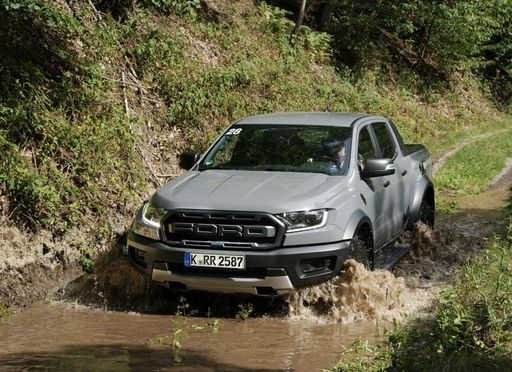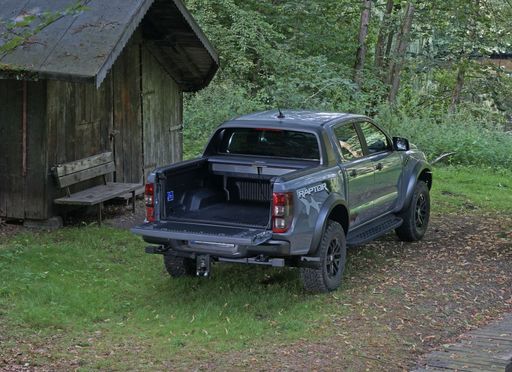Ford Ranger vs Mazda 3 Sedan – Differences & prices compared
Compare performance, boot space, consumption and price in one view.
Find out now: which car is the better choice for you – Ford Ranger or Mazda 3 Sedan?
The Ford Ranger (Pickup) comes with a Diesel, Petrol or Plugin Hybrid engine and Manuel or Automatic transmission. In comparison, the Mazda 3 Sedan (Sedan) features a Petrol MHEV engine with Manuel or Automatic transmission.
When it comes to boot capacity, the Ford Ranger offers , while the Mazda 3 Sedan provides 450 L – depending on how much space you need. If you’re looking for more power, decide whether the 292 HP of the Ford Ranger or the 186 HP of the Mazda 3 Sedan suits your needs better.
In terms of consumption, the values are 3.10 L per 100 km for the Ford Ranger, and 5.50 L for the Mazda 3 Sedan.
Price-wise, the Ford Ranger starts at 34500 £, while the Mazda 3 Sedan is available from 25000 £. Compare all the details and find out which model fits your lifestyle best!
Ford Ranger
The Ford Ranger stands out in the pickup market with its robust build and versatile capabilities, making it a popular choice for both work and leisure. Its modern design is complemented by a well-equipped interior, providing comfort and advanced technology. Whether tackling challenging terrains or cruising through the city, the Ranger delivers a reliable and dynamic driving experience.
details @ media.ford.com
@ media.ford.com
 @ media.ford.com
@ media.ford.com
Mazda 3 Sedan
The Mazda 3 Sedan stands out with its elegant and sleek design, capturing attention on the road with its refined aesthetics. Inside, it offers a well-crafted and comfortable cabin, providing a pleasurable driving experience marked by quality materials and advanced features. The car's performance is reliable and smooth, making it a versatile choice for both city driving and long-distance journeys.
details

|
|
|
|
|
Costs and Consumption |
|
|---|---|
|
Price
34500 - 68800 £
|
Price
25000 - 34200 £
|
|
Consumption L/100km
3.1 - 13.8 L
|
Consumption L/100km
5.5 - 6.1 L
|
|
Consumption kWh/100km
-
|
Consumption kWh/100km
-
|
|
Electric Range
50 km
|
Electric Range
-
|
|
Battery Capacity
11.80 kWh
|
Battery Capacity
-
|
|
co2
70 - 315 g/km
|
co2
123 - 135 g/km
|
|
Fuel tank capacity
80 L
|
Fuel tank capacity
51 L
|
Dimensions and Body |
|
|---|---|
|
Body Type
Pickup
|
Body Type
Sedan
|
|
Seats
2 - 5
|
Seats
5
|
|
Doors
2 - 4
|
Doors
4
|
|
Curb weight
2082 - 2486 kg
|
Curb weight
1420 - 1492 kg
|
|
Trunk capacity
-
|
Trunk capacity
450 L
|
|
Length
5370 - 5420 mm
|
Length
4660 mm
|
|
Width
1918 - 1968 mm
|
Width
1795 mm
|
|
Height
1868 - 1922 mm
|
Height
1440 mm
|
|
Payload
676 - 1108 kg
|
Payload
467 - 481 kg
|
Engine and Performance |
|
|---|---|
|
Engine Type
Diesel, Petrol, Plugin Hybrid
|
Engine Type
Petrol MHEV
|
|
Transmission
Manuel, Automatic
|
Transmission
Manuel, Automatic
|
|
Transmission Detail
Manual Gearbox, Automatic Gearbox
|
Transmission Detail
Manual Gearbox, Automatic Gearbox
|
|
Drive Type
All-Wheel Drive
|
Drive Type
Front-Wheel Drive
|
|
Power HP
170 - 292 HP
|
Power HP
140 - 186 HP
|
|
Acceleration 0-100km/h
7.9 - 12.1 s
|
Acceleration 0-100km/h
8.1 - 9.8 s
|
|
Max Speed
180 - 190 km/h
|
Max Speed
203 - 216 km/h
|
|
Torque
405 - 697 Nm
|
Torque
238 - 240 Nm
|
|
Number of Cylinders
4 - 6
|
Number of Cylinders
4
|
|
Power kW
125 - 215 kW
|
Power kW
103 - 137 kW
|
|
Engine capacity
1996 - 2993 cm3
|
Engine capacity
1998 - 2488 cm3
|
General |
|
|---|---|
|
Model Year
2022 - 2025
|
Model Year
2025
|
|
CO2 Efficiency Class
G, B
|
CO2 Efficiency Class
D
|
|
Brand
Ford
|
Brand
Mazda
|
Ford Ranger
A Comprehensive Look at the Ford Ranger: Versatility Meets Innovation
The Ford Ranger has long been a staple in the world of pick-up trucks, renowned for its robust design and versatility. Whether for rugged off-road adventures or everyday utility tasks, the Ford Ranger continues to be a frontrunner in the pick-up segment. In this article, we explore the technical details and innovative features that set the latest versions of the Ford Ranger apart from its competitors.
Powertrain Performance: A Range of Choices
The Ford Ranger offers a selection of powerful engines, catering to a diverse set of user requirements. Engine options range from the fuel-efficient 2.0-litre EcoBlue diesel engine to the robust 3.0-litre EcoBoost petrol engine, offering impressive outputs from 170 to 292 PS. These engines are paired with either a manual or an advanced automatic transmission, both providing smooth shifting and optimised performance across various driving conditions.
The Ranger’s all-wheel-drive system ensures a robust off-road capability while maintaining a composed ride on urban roads. With torque figures ranging between 405 Nm and 600 Nm, the Ranger guarantees ample pulling power whether you're on or off the beaten track.
Fuel Efficiency and Environmental Considerations
Recognising the importance of balancing performance with efficiency, the Ford Ranger delivers competitive fuel consumption figures ranging from 8.4 to 13.8 litres per 100 km. Despite its robust performance capabilities, the Ranger remains mindful of its environmental footprint, maintaining a functional balance between power and efficiency with a CO2 efficiency class of G.
Advanced Safety and Technology Features
Incorporating cutting-edge technology, the Ford Ranger is equipped with a suite of safety features designed to protect both passengers and payload. Among these are adaptive cruise control, lane-keeping assistance, and a pre-collision assist system, enhancing the driver's ability to navigate both rural roads and busy motorways safely and efficiently.
Moreover, the interior tech suite includes an intuitive infotainment system, complete with connectivity options for seamless integration of smartphones and smart devices. This ensures drivers and passengers can stay connected and entertained on all journeys.
Customisation and Comfort
The Ford Ranger offers a variety of trim levels, allowing customers to tailor the vehicle to their specific needs. From the rugged XL 4x4 to the luxurious Platinum e-4WD Automatik, there is a model to suit every preference and requirement. Equipment lines such as Wildtrak and MS-RT add enhanced styling and additional features for those seeking a more distinctive and upscale appearance.
Inside, the Ranger provides comfortable seating configurations for up to five passengers, with premium materials and ample storage space to ensure every journey is a pleasant experience. Users can also benefit from a range of comfort features, including climate control, premium audio systems, and adjustable seating.
Practicality Meets Payload
The Ford Ranger excels in practicality with its impressive payload capacity and spacious cargo bed, suitable for carrying everything from work equipment to recreational gear. With a maximum payload of up to 1,108 kg, the Ranger is more than capable of handling heavy loads, making it an ideal choice for both professional and personal use.
Additionally, the robust chassis and durable build quality provide long-lasting performance even under the most demanding conditions, ensuring reliability and endurance in the long term.
Conclusion: A Resilient Companion for All Terrains
With its capable engine choices, outstanding off-road capabilities, and a host of advanced features, the Ford Ranger continues to lead the way in the pick-up truck category. Whether for practical utility, adventurous pursuits, or simply as a reliable daily vehicle, the Ranger delivers on all fronts – a true testament to Ford’s commitment to innovation and quality in the automotive industry.
Mazda 3 Sedan
Introduction to the Mazda 3 Sedan
Unveiling the 2024 Mazda 3 Sedan, a vehicle that gracefully combines elegance with innovation. This model is an exemplar of Mazda's commitment to pushing the boundaries of design and performance. The Mazda 3 Sedan is available with a choice of engines that blend efficiency with power, ensuring a drive that's as rewarding as it is economical.
Advanced Powertrains
The heart of the Mazda 3 Sedan lies in its cutting-edge engine options. Equipped with a 2.0-litre e-SKYACTIV-X engine, this sedan delivers up to 186 PS while maintaining excellent fuel efficiency. For those seeking a balance between power and efficiency, the e-SKYACTIV-G engine with 140 PS is an ideal choice. Both engines utilize mild-hybrid technology, enhancing performance and reducing emissions.
Efficiency Meets Performance
Boasting an impressive fuel consumption range between 5.5 to 6.1 L/100km, the Mazda 3 Sedan is perfect for both city commutes and long drives. With emissions rated at 123 to 135 g/km, it strikes a sustainable balance without compromising on performance. Acceleration from 0 to 100 km/h takes just 8.1 seconds with the most powerful variant, highlighting its agile character.
Specifications and Pricing
From the entry-level Center-Line to the luxurious Takumi trim, the Mazda 3 Sedan offers a range of equipment lines catering to a variety of tastes and needs. The pricing is competitive, starting from €28,640 and reaching up to €39,390, offering remarkable value for a car of this class. Monthly costs range between €961 to €1080, reflecting its economic viability.
Design and Comfort
The Mazda 3 Sedan’s dimensions (4,660 mm in length, 1,795 mm in width, and 1,440 mm in height) create a sleek profile that underscores its sophisticated design philosophy. Inside, the cabin is spacious, comfortably accommodating five passengers, while the boot offers a practical 450 litres of luggage space, ideal for both daily tasks and longer trips.
Innovative Technology and Features
The Mazda 3 Sedan impresses with a suite of advanced technologies, enhancing safety and convenience. Front-wheel drive ensures stability and control, while advanced driver assistance systems provide support during challenging driving conditions.
Concluding Thoughts
The 2024 Mazda 3 Sedan represents a harmonious blend of performance, efficiency, and modern technology. Its stylish design and innovative features make it a compelling choice for those seeking a sophisticated and reliable sedan. Whether you're after a manual transmission for a more engaged driving experience or the convenience of an automatic, the Mazda 3 Sedan delivers on all fronts.
Which drive types are available for the Ford Ranger?
Available as All-Wheel Drive.
The prices and data displayed are estimates based on German list prices and may vary by country. This information is not legally binding.
